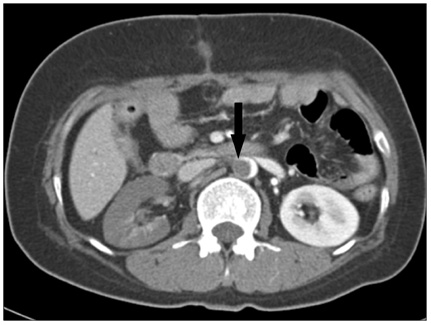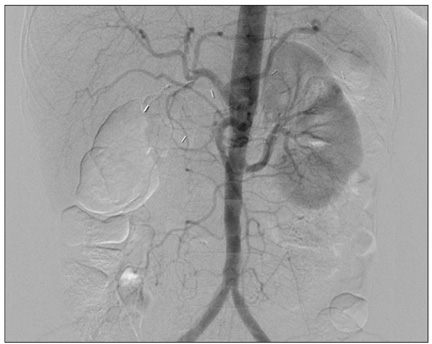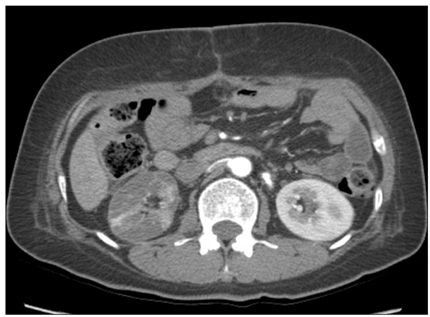J Korean Surg Soc.
2011 Dec;81(Suppl 1):S78-S81. 10.4174/jkss.2011.81.Suppl1.S78.
Successful hybrid operation of an acute mobile thrombus in the abdominal aorta induced by chemotherapy
- Affiliations
-
- 1Department of Radiology, Inha University School of Medicine, Incheon, Korea. radjeon@inha.ac.kr
- 2Department of Surgery, Inha University School of Medicine, Incheon, Korea.
- KMID: 1445792
- DOI: http://doi.org/10.4174/jkss.2011.81.Suppl1.S78
Abstract
- Acute mobile thrombus of the abdominal aorta after chemotherapy is a very unusual finding, which can be a potential source of arterial embolism. We report here on a case of an acute mobile aortic thrombus with renal infarction. We successfully treated the patient with hybrid operation-open surgical and endovascular approach. Our case shows that hybrid treatment using wire-directed balloon catheter thrombectomy is a feasible, minimally-invasive treatment for a mobile aortic thrombus.
Keyword
MeSH Terms
Figure
Reference
-
1. Kalangos A, Baldovinos A, Vuille C, Montessuit M, Faidutti B. Floating thrombus in the ascending aorta: a rare cause of peripheral emboli. J Vasc Surg. 1997. 26:150–154.2. Tunick PA, Lackner H, Katz ES, Culliford AT, Giangola G, Kronzon I. Multiple emboli from a large aortic arch thrombus in a patient with thrombotic diathesis. Am Heart J. 1992. 124:239–241.3. ten Kate MK, van der Meer J. Protein S deficiency: a clinical perspective. Haemophilia. 2008. 14:1222–1228.4. Licciardello JT, Moake JL, Rudy CK, Karp DD, Hong WK. Elevated plasma von Willebrand factor levels and arterial occlusive complications associated with cisplatin-based chemotherapy. Oncology. 1985. 42:296–300.5. Kim SD, Hwang JK, Lee JH, Cho HJ, Sung GY, Moon IS, et al. Free floating thrombus of the aorta: an unusual cause of peripheral embolization. J Korean Surg Soc. 2011. 80:204–211.6. Choukroun EM, Labrousse LM, Madonna FP, Deville C. Mobile thrombus of the thoracic aorta: diagnosis and treatment in 9 cases. Ann Vasc Surg. 2002. 16:714–722.7. Lozano P, Gomez FT, Julia J, M-Rimbau E, Garcia F. Recurrent embolism caused by floating thrombus in the thoracic aorta. Ann Vasc Surg. 1998. 12:609–611.8. Zhang WW, Abou-Zamzam AM, Hashisho M, Killeen JD, Bianchi C, Teruya TH. Staged endovascular stent grafts for concurrent mobile/ulcerated thrombi of thoracic and abdominal aorta causing recurrent spontaneous distal embolization. J Vasc Surg. 2008. 47:193–196.9. Shammas NW, Dippel EJ, Coiner D, Shammas GA, Jerin M, Kumar A. Preventing lower extremity distal embolization using embolic filter protection: results of the PROTECT registry. J Endovasc Ther. 2008. 15:270–276.10. Mackman N. Triggers, targets and treatments for thrombosis. Nature. 2008. 451:914–918.
- Full Text Links
- Actions
-
Cited
- CITED
-
- Close
- Share
- Similar articles
-
- Acute Abdominal Mobile Aortic Thrombus Post Chemotherapy: Two Cases Reports
- Floating Thrombus in Aortic Arch
- Hybrid Surgery for Supra-renal Abdominal Aortic Aneurysm: A case report
- A Case of Mobile Thrombus in Ascending Aorta as an Embolic Source of Stroke
- Hybrid Repair of Suprarenal Abdominal Aortic Aneurysm: Antegrade Debranching with Endovascular Aneurysm Repair





